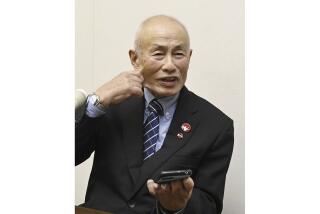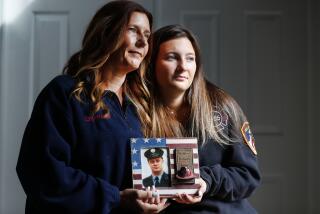‘Day of Remembrance’ Brings Prayers of Peace
Pat Hirata, a small, youthful-looking woman of 74, stood before an audience in Los Angeles on Saturday morning and tried to conjure a time and place where her fate and the rest of mankind’s were forever altered:
The night before the dropping of the bomb on Hiroshima, she began, I and my two older sisters were watching the night sky from the window upstairs. It was so calm, and the stars were so beautiful that I felt they were even showering us. Three sisters spending the night together, counting shooting stars. We never saw so many of them before.
About 200 people had gathered in the George J. Doizaki Gallery at the Japanese American Cultural and Community Center in Little Tokyo to observe the 60th anniversary of the atomic bombing of Hiroshima and Nagasaki, Japan, during World War II. The Day of Remembrance was sponsored by the Nikkei Interfaith Fellowship.
Traditional Japanese music, drumming and appeals to heaven were marshaled to banish the forgetfulness that inevitably besets human beings as years become decades and life closes over even the most cavernous of wounds.
In Hiroshima itself, where an estimated 140,000 perished, people are less and less attentive to the calamity, according to a documentary film screened at the event. What the Day of Remembrance needed more than anything was a storyteller, and that was Hirata, who at the time of the bombing was a 14-year-old girl working in a weapons factory.
August the 6th was a bright, sunny morning. I arrived at the factory early and went outside with a friend to drink water from the faucet. It all happened at that moment.
For the screening of the new film “The Mushroom Club,” by Academy Award-winning documentarian Steven Okazaki, the audience was gently summoned to order by the breathy tones of the shakuhachi, the traditional Japanese bamboo flute.
The filmmaker had visited several Hiroshima residents who survived the bombing -- an 85-year-old woman who searches for old buttons amid the gravel alongside the city’s rivers because the buttons, she says, represent to her the souls of nameless victims; two 59-year-old women who have the minds of 8-year-olds because they were in their mothers’ wombs when the radiation-spewing bomb went off; a 66-year-old comic book artist and animator whose cartoons frightfully depict what happened to people that morning.
We were exposed to a sudden, intensive light, as if a giant photographic flash occurred, Hirata continued. I turned and saw a huge fireball joined to a giant mushroom cloud. It was approaching us very fast, so we dashed into the building.
After the film, the audience filed outside to the pavilion. In the brilliant, late-morning sun, two troops of taiko drummers, one from Centenary United Methodist Church and one from Higashi Honganji Buddhist Temple, arrayed themselves in dramatic martial-arts stances and, synchronously swirling their arms, beat out swelling, ebbing, intricate rhythms that resounded through Little Tokyo.
When the dust settled, glass was shattered all over, as if a tornado had hit us.... After a while we went outdoors and saw many injured people. Their clothing was torn and they were walking, phantoms, to the countryside.... We saw soldiers after soldiers who were so badly burned that their skin was barely hanging on their bodies ... and the soldiers said to the 14-year-old girls crying, “You are Japanese. Be brave. Don’t cry.”
When the audience returned to the gallery, it heard a song played by a dozen ceremonially dressed musicians of an orchestra that played gagaku, traditional music of the Japanese imperial court and, a spokesman for the group announced, the oldest continuously performed music in the world.
Seated on a carpet with their assortment of drums and ancient wind instruments, they keened an otherworldly tune from 10th century Kyoto.
After the film and the drums and the music, master of ceremonies Rev. Dickson Yagi asked, “Can we have a few moments of silence so we can digest all of this in our spirit?” For the next few minutes, nothing could be heard but the distant hum of the air-conditioning system.
Then Hirata began her story.
My mother suffered great injuries from flying glass. There were dying citizens outside the doors, begging for water. I had difficulty believing that their voices were coming from fellow human beings....
One of my sisters did not return home that night, so we prayed for her safe return. Four days later ... my brother went on bicycle and brought her home. When I saw her, my heart almost stopped. Her condition was far worse than the victims I saw before. Her face, her arms were charred black and had swollen to double in size, and the maggots were crawling in her wounds....
Four days later, my sister thanked everyone and died. She was 19 years of age. We loaded her body on a hand truck and went to the nearby park. We dug a hole and laid her over fire. Our father stayed by himself to cremate his own daughter.
The audience filed back out to the pavilion and queued before an altar to make offerings. Buddhists placed grains of incense on fires smoldering in five white bowls. Christians laid white, pink and purple chrysanthemum buds on the altar cloth.
Let us think of peace now. The memories have come again. Sixty years have passed since the atomic bomb fell on Hiroshima, my hometown. How wonderful is peace....
More to Read
Sign up for Essential California
The most important California stories and recommendations in your inbox every morning.
You may occasionally receive promotional content from the Los Angeles Times.









